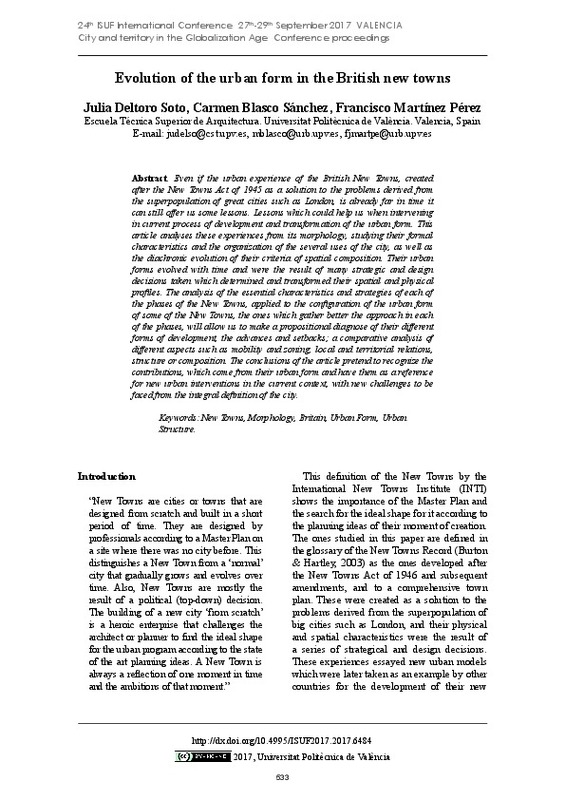JavaScript is disabled for your browser. Some features of this site may not work without it.
Buscar en RiuNet
Listar
Mi cuenta
Estadísticas
Ayuda RiuNet
Admin. UPV
Evolution of the Urban Form in the British New Towns
Mostrar el registro sencillo del ítem
Ficheros en el ítem
| dc.contributor.author | Deltoro Soto, María Julia
|
es_ES |
| dc.contributor.author | Blasco Sánchez, María del Carmen
|
es_ES |
| dc.contributor.author | Martínez Pérez, Francisco Juan
|
es_ES |
| dc.coverage.spatial | east=-3.43597299999999; north=55.378051; name= Regne Unit | es_ES |
| dc.date.accessioned | 2018-12-28T07:54:15Z | |
| dc.date.available | 2018-12-28T07:54:15Z | |
| dc.date.issued | 2018-04-20 | |
| dc.identifier.isbn | 9788490485743 | |
| dc.identifier.uri | http://hdl.handle.net/10251/114551 | |
| dc.description.abstract | [EN] Even if the urban experience of the British New Towns, created after the New Towns Act of 1945 as a solution to the problems derived from the superpopulation of great cities such as London, is already far in time it can still offer us some lessons. Lessons which could help us when intervening in current process of development and transformation of the urban form. This article analyses these experiences from its morphology, studying their formal characteristics and the organization of the several uses of the city, as well as the diachronic evolution of their criteria of spatial composition. The First New Towns mainly followed the characteristics stated in the Reith Report [HMSO, 1946 a] and the consequent New Towns Act [HMSO, 1946 b], which defined the scale of the new cities, their uses and zoning, location, areas, distances, social structure or landscape among other. Their urban forms evolved with time and were the result of many strategic and design decisions taken which determined and transformed their spatial and physical profiles. According to the Town and Country Planning Association [TCPA, 2014] New Towns can be classified in three Marks as for their chronology and the laws that helped to create them. But if we focus in their urban form, we can find another classification by Ali Madani-Pour, [1993] who divides them into four design phases, which give answer to different social needs and mobility. The analysis of the essential characteristics and strategies of each of the phases of the New Towns, applied to the configuration of the urban form of some of the New Towns, the ones which gather better the approach in each of the phases, will allow us to make a propositional diagnose of their different forms of development, the advances and setbacks; a comparative analysis of different aspects such as mobility and zoning, local and territorial relations, structure or composition. The conclusions of the article pretend to recognize the contributions, which come from their urban form and have them as a reference for new urban interventions in the current context, with new challenges to be faced from the integral definition of the city. | es_ES |
| dc.format.extent | 10 | es_ES |
| dc.language | Inglés | es_ES |
| dc.publisher | Editorial Universitat Politècnica de València | es_ES |
| dc.relation.ispartof | 24th ISUF International Conference. Book of Papers | es_ES |
| dc.rights | Reconocimiento - No comercial - Sin obra derivada (by-nc-nd) | es_ES |
| dc.subject | New towns | es_ES |
| dc.subject | Morphology | es_ES |
| dc.subject | Britain | es_ES |
| dc.subject | Urban form | es_ES |
| dc.subject | Urban structure | es_ES |
| dc.title | Evolution of the Urban Form in the British New Towns | es_ES |
| dc.type | Capítulo de libro | es_ES |
| dc.type | Comunicación en congreso | es_ES |
| dc.identifier.doi | 10.4995/ISUF2017.2017.6484 | |
| dc.rights.accessRights | Abierto | es_ES |
| dc.contributor.affiliation | Universitat Politècnica de València. Departamento de Urbanismo - Departament d'Urbanisme | es_ES |
| dc.contributor.affiliation | Universitat Politècnica de València. Escuela Técnica Superior de Arquitectura - Escola Tècnica Superior d'Arquitectura | es_ES |
| dc.description.bibliographicCitation | Deltoro Soto, MJ.; Blasco Sánchez, MDC.; Martínez Pérez, FJ. (2018). Evolution of the Urban Form in the British New Towns. En 24th ISUF International Conference. Book of Papers. Editorial Universitat Politècnica de València. 533-542. https://doi.org/10.4995/ISUF2017.2017.6484 | es_ES |
| dc.description.accrualMethod | OCS | es_ES |
| dc.relation.conferencename | 24th ISUF 2017 - City and Territory in the Globalization Age | es_ES |
| dc.relation.conferencedate | Septiembre 27-29,2017 | es_ES |
| dc.relation.conferenceplace | Valencia, Spain | es_ES |
| dc.relation.publisherversion | http://ocs.editorial.upv.es/index.php/ISUF/ISUF2017/paper/view/6484 | es_ES |
| dc.description.upvformatpinicio | 533 | es_ES |
| dc.description.upvformatpfin | 542 | es_ES |
| dc.type.version | info:eu-repo/semantics/publishedVersion | es_ES |
| dc.relation.pasarela | OCS\6484 | es_ES |








